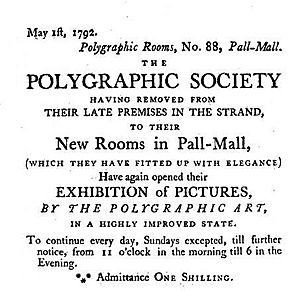Joseph Booth (actor) facts for kids
Joseph Booth (whose stage name was Booth, but his real last name was Martin) was an English tradesman, actor, and inventor. He lived in the 1700s and is remembered for his work in theater and for inventing a special way to copy paintings. He died in 1797.
Contents
Booth's Acting Life
Joseph Booth's early life isn't very well known. He first worked as a hosier, selling socks and stockings, in Mansfield. Later, he decided to become an actor and joined the stage.
Around 1774, Booth was managing a theater company in northern England, in places like Carlisle. This was a temporary job, as the main manager was away. Famous people like Elizabeth Inchbald and William Shield were part of his company. Later, around 1780, he worked as an assistant prompter at the Covent Garden Theatre in London. He also claimed to have invented something for making textiles.
The Polygraphic Society
In London, Joseph Booth started a company called the Polygraphic Society. This society held art shows every year. Booth first explained his idea in a pamphlet in 1784. The society also sold copies of paintings, which they called "polygraphic" works.
What is Polygraphic Art?
The first list of polygraphic paintings had 24 artworks. It was sold from The Strand, London. By 1792, their list had 80 paintings, and the society was located in Pall Mall. They even added special stone figures to the porch of their building in 1791.
The first name for these copied artworks was "pollaplasiasmos." An important American, Thomas Jefferson, bought one of these copies in London. It was a painting called The Prodigal Son by Benjamin West, and it hung in his home at Monticello.
The Workshop and Its Artists
The Polygraphic Society had a workshop in Woolwich Common. Sadly, this workshop was destroyed by a fire in 1793. In the workshop, artists would finish the printed copies of paintings by adding oil paints. Some artists who worked there included James Baynes and Isaac Jehner.
The Society Closes
The Polygraphic Society closed down in 1794. Towards the end, it shared its building with another art gallery. The last show of polygraphic pictures started in December 1794. Then, in April 1795, there was a final auction to sell everything.
After Booth's Death
Joseph Booth passed away on February 25, 1797. Even after he died, some people continued to work with the polygraphic art. An artist named James Sillett wrote in 1808 that the secret process for making these copies was not lost. He said that Booth had sold his share of the business before he died.
The Legacy of Polygraphic Art
The "polygraphic art" continued to be discussed. Some people tried to keep the art form going. Later, in the 1860s, Booth's polygraphic works were even mentioned in discussions about who invented photography first.
Booth's Family
Joseph Booth was married to an actress named Malatratt. Their son was William Martin, who became a naturalist.


